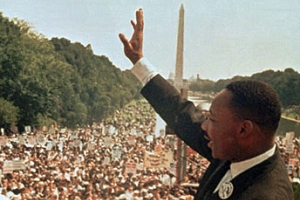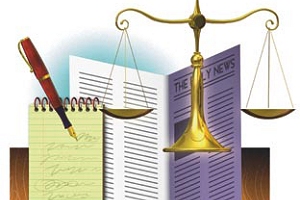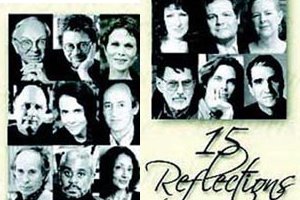America in context
Protecting Minority Rights

"I have a dream that my four little children will one day live in a nation where they will not be judged by the color of their skin but by the content of their character."
-- Dr. Martin Luther King, Jr.
March on Washington Speech, August, 1963
The framers of the U.S. Constitution left to future generations resolution of the slavery issue, and the Civil War and Reconstruction provided only temporary relief from racial discrimination for former slaves and their descendants. By the mid-1950s, however, the U.S. Supreme Court had begun to subject laws that discriminate on the basis of a persons race, color, or national origin to strict judicial scrutiny, prohibiting virtually all forms of government-based racial discrimination.
Congress, too, began to outlaw public and private racial discrimination in voting, employment, public accommodations, housing, and federally funded programs. Later, the high Court subjected laws based on gender to heightened scrutiny also, while Congress not only banned sex discrimination in a variety of fields but also forbade unequal treatment based on disability.
Discrimination: an affront to a democratic society
Virtually throughout its history, the United States has been obliged to confront these sorts of questions in resolving a variety of issues affecting minorities and other disadvantaged groups -- from the painful struggle over slavery and its remnants, to the nations expansion of equality principles to gender and other non-racial forms of discrimination, to attempts to define and assure an equal competitive field for disabled Americans, to recent efforts to include sexual orientation among the privacy rights subject to legal protection.
Several basic themes have permeated each of these movements. First is the notion that certain forms of discrimination are an affront to the concept of an open, democratic society. President John F. Kennedy eloquently evoked this principle in his 1963 address to the nation, following the court-ordered desegregation of the University of Alabama over the opposition of Alabamas segregationist governor George Wallace. "I hope," the president observed that evening, "that every American, regardless of where he lives, will stop and examine his conscience about this and other related incidents. This nation was founded by men of many nations and backgrounds. It was founded on the principle that all men are created equal and that the rights of every man are diminished when the rights of one man are threatened."
Later that summer, Martin Luther King, Jr., the foremost civil rights leader of his era, movingly voiced another basic refrain of the equality movement in his "I Have a Dream" speech climaxing that years civil rights march on Washington. Speaking before a crowd of 200,000 at the memorial to President Abraham Lincoln, who signed the Emancipation Proclamation ending slavery, Dr. King decried the unfairness of a society in which public policy and private practice are based on stereotypical assumptions about human worth. "I have a dream," King proclaimed, "that my four little children will one day live in a nation where they will not be judged by the color of their skin but by the content of their character."
Finally, movements to protect minorities and other disadvantaged groups have been motivated and gained support through practical considerations of self-interest. If a society is permitted to discriminate against one class of people, what is to prevent it from giving force to its other prejudices? Many citizens may realize that discrimination against members of one race, religion, ethnic background, or unorthodox practice or orientation could lead to attacks on other target groups.
The campaign against slavery
Influenced by such concerns, the United States has gradually expanded the types of discrimination the nation will no longer tolerate, attacking them in the judicial, legislative, and executive arenas, as well as in the court of public opinion. The campaign against slavery and its vestiges has been the most frustrating and protracted of those campaigns. When the nation celebrated the 200th anniversary of the adoption of its Constitution in the 1980s, Thurgood Marshall, chosen in 1967 as the first African American ever to serve on the nations Supreme Court, asserted that persons of his race had little reason to applaud enactment of the original Constitution. Instead, said Marshall, African Americans should reserve their praise for the 13th, 14th, and 15th Amendments to the Constitution, the Civil War and Reconstruction-era bans on slavery and discrimination in voting and in other areas of national life.
The rights of all minorities
African Americans, of course, have not been the only target of discrimination in the United States. The history of the nations treatment of Native Americans has been equally regrettable. For years, Congress and the courts promoted Western expansion at the expense of Indian property rights, confiscating their lands and isolating them in often poor living conditions on reservations.
But Indians were eventually given citizenship and the right to vote. Beginning in the 1960s, moreover, Indian civil rights groups mobilized, winning important victories with respect to hunting, fishing, and land rights, including protection for burial grounds and other sacred sites. In an important 1990 case, however, the Supreme Court refused to extend meaningful protection to some tribes ritual use of peyote, concluding that religious practices were obliged to conform to religiously neutral criminal laws, including drug regulations.
The diverse Hispanic-American populations have had similar difficulty becoming assimilated into American life. Language barriers and national concerns over illegal immigration, particularly from Mexico, have made Hispanics likely targets of discrimination in employment, housing, and education. Spanish, moreover, has been the principal target of the movement to make English the nations official language, but Hispanic Americans, like other U.S. minority groups, have also made progress in recent years. In 1982, the Supreme Court struck down a Texas policy excluding undocumented children of illegal immigrants from free public schooling, with the justices emphasizing the importance of an education to a childs future development.
While not a numerical minority of the nations population, American women were, like those in most countries, traditionally subjected to a variety of disabilities based on assumptions about gender. Prior to the adoption of the 19th Amendment to the U.S. Constitution in 1920, the courts routinely upheld state laws denying women the right to vote. A number of early decisions sustained laws prohibiting women from practicing law, medicine, or certain other professions. Indeed, as late as 1961, the Supreme Court upheld a Florida law excluding women from jury service unless they specifically expressed a desire to serve. Sex, however, would appear little more relevant than race as an appropriate basis for government distribution of benefits and burdens. Like African Americans, women were also long systematically excluded from the political process and thus the opportunity to exert control over their own destinies.
The United States has generally been more reluctant to forbid discrimination based on sexual orientation or to recognize the right of consenting adults to engage in homosexual relationships. A number of cities, counties, or states have included sexual preference among forbidden forms of classification, and a few have gone so far as to recognize gay marriages. In Romer v. Evans (1996), a 6-3 Supreme Court majority overturned on equal protection grounds a state constitutional amendment that banned all current and future regulations protecting persons from discrimination based on sexual preference. Although declining to declare homosexuals a specially protected class, the Court condemned the amendment as a forbidden state attempt to relegate homosexuals to the status of second-class citizens.
The debate over affirmative action
In an effort to remedy the effects of past bias against racial minorities and women in employment and higher education, government agencies and universities since the 1960s have established programs extending varying degrees of preference to minorities and women in admission, employment, and advancement decisions. Supporters of such programs have contended that they are temporary measures to assure fair treatment for members of groups historically subject to purposeful discrimination and to hasten the creation of a truly integrated society. The defenders of affirmative action emphasized, moreover, that when white men, the alleged victims of such programs, charged "reverse discrimination," this established group could hardly be compared with African Americans and other groups long subjected to mistreatment based on their race or color, and thus now entitled to special judicial protection. In addition to arguing that affirmative action programs constituted unconstitutional "reverse discrimination," critics pointed out that affirmative action ran counter to the concept of a "color-blind" Constitution, violated the principle of advancement based on merit, aggravated racial hostilities, and perhaps generated feelings of inferiority in those they were designed to help.
The credo of individual equality
Through judicial decisions, congressional statutes, executive enforcement, and changing public attitudes, American society has steadily evolved toward recognizing minority rights in law. The United States has largely banished the more blatant inequities African-Americans and other historically disadvantaged groups were long forced to endure. We are much closer to the day when Justice Harlans resounding dissent in the 1896 Plessy decision rings substantially true: "In view of the Constitution, in the eye of the law, there is in this country no superior, dominant, ruling class of citizens. There is no caste here."
The fight to end discrimination against minorities in the United States has taken place primarily in courts of law and in Congress and state legislatures. These efforts have proven successful for two reasons. One is the rule of law, and the abiding belief by the American people that even if individuals or groups do not agree with the conclusion of the courts or legislatures in establishing policy, citizens are bound to obey this policy. If they disagree with a policy or law, they lobby the legislatures and sue in the courts, rather than rampaging in the streets.
The second reason is that the American civic religion, as embodied in the Constitution, the Declaration of Independence and a long tradition of legislatures and courts, holds that all persons are created equal, and are entitled to equal protection under the law. Even if individual Americans do not like particular groups because of their skin color, their lifestyles, or their language, the widespread credo of individual equality forces Americans to confront their prejudices. Although the nation is still not free from its history of discrimination against certain groups, it is publicly committed eventually to ending all vestiges of racial and other forms of prejudice.
For Additional Reading
Tinsley E. Yarbrough, Protecting Minority Rights, Democracy Papers, U.S. Department of State, Bureau of International Information Programs, 2001
Justice For All: The Legacy of Thurgood Marshall, U.S. Department of State, Bureau of International Information Programs, January 2007
The Martin Luther King We Remember, By Adam Wolfson and Daniel Patrick Moynihan, The Public Interest, Issue #152, (Summer 2003), National Affairs, Inc
Charles A. Lofgren, The Plessy Case (Oxford, 1987)
Richard F. Kluger, Simple Justice: The History of Brown v. Board of Education and Black Americas Struggle for Equality (Knopf, 1976)
J. Harvie Wilkinson, III, From Brown to Bakke (Oxford, 1979)
Deborah Rhode, Justice and Gender (Harvard, 1989)
Andrew Kull, The Color-Blind Constitution (Harvard, 1994)
--------------------------------------------------------------------------------
About the Author:
Tinsley E. Yarbrough is Arts and Sciences Distinguished Professor of Political Science at East Carolina University in Greenville, N.C. He is the author of books on several jurists, including Supreme Court Justice Hugo L. Black and the two justices (grandfather and grandson) named John Marshall Harlan. His most recent books are The Rehnquist Court and the Constitution (Oxford, 2000) and The Burger Court: Justices, Rulings and Legacy (ABC-CLIO, 2001).
Recently on America in context
Freedom's Watchdog: The Press in the U.S.
 "It is well to remember that freedom through the press is the thing that comes first," Murrow told the New York Herald Tribune in 1958, stressing his own belief in a great democratic institution. "Most of us probably feel we couldn't be free without newspapers, and that is the real reason we want the newspapers to be free."
"It is well to remember that freedom through the press is the thing that comes first," Murrow told the New York Herald Tribune in 1958, stressing his own belief in a great democratic institution. "Most of us probably feel we couldn't be free without newspapers, and that is the real reason we want the newspapers to be free."
Writers on America
 If we were to ask a contemporary group of American poets, novelists, critics, and historians what it means to be an American writer, the results could illuminate in an interesting way certain America values -- freedom, diversity, democracy -- that may not be well understood in all parts of the world.
If we were to ask a contemporary group of American poets, novelists, critics, and historians what it means to be an American writer, the results could illuminate in an interesting way certain America values -- freedom, diversity, democracy -- that may not be well understood in all parts of the world.
Environment: A Book That Changed a Nation
 A shy, unassuming scientist and former civil servant, Rachel Carson love of nature and love of writing compelled her in 1962 to publish Silent Spring, the book that awakened environmental consciousness in the American public and led to an unprecedented national effort to safeguard the natural world from chemical destruction.
A shy, unassuming scientist and former civil servant, Rachel Carson love of nature and love of writing compelled her in 1962 to publish Silent Spring, the book that awakened environmental consciousness in the American public and led to an unprecedented national effort to safeguard the natural world from chemical destruction.